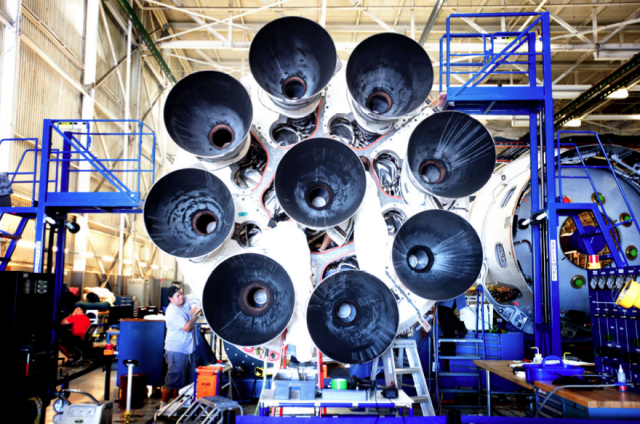New engines, larger launch vehicle, and a controlled reentry of the first stage.
Earlier today, SpaceX successfully sent an upgraded version of its Falcon 9 launch vehicle into space, putting a Canadian science platform and three smaller satellites into orbit. However, the launch was mostly interesting because of what happened after the payload was released. For the first time, the Falcon 9's main stage performed a controlled burn that safely brought it back into the atmosphere.
"It was a great day, and we accomplished all our objectives successfully," SpaceX founder Elon Musk said during a press call this afternoon. Communications had been established with all the satellites that were taken to orbit. The primary payload was Canada's CASSIOPE, which includes a set of environmental sensors linked to a test communication platform. The other three payloads included two university payloads and a small CubeSat.
 |
| The new engines and their altered configuration on the Falcon 9 v1.1. |
Normally, for a launch like this, the payloads are where the action is. But today's was substantially different, involving an upgraded version of the Falcon 9 booster. The new rocket features the Merlin 1D engine, which delivers more thrust and is easier to manufacture. The nine Merlin engines on the booster have also been rearranged, going from a grid-like formation to one where a circle of eight surrounds a central engine. The v1.1 is taller than its predecessor and features a larger fairing to hold its payload (the new one is five meters, roughly 16.5 feet, in diameter).
Perhaps more significantly, v1.1 is set up so that SpaceX can have it back. The company has been using a testbed called Grasshopper to explore controlled landings of the rocket. Today's flight involved tests of a necessary counterpart: getting the boost stage from its launch trajectory back into the atmosphere in a controlled manner. After the second stage separated today, the boost stage reversed its orientation and fired some of its engines to slow its flight, allowing it to undergo reentry without a problem. Musk said that, upon reentry, boost phases "normally explode due to extreme forces."
Once it was back in the atmosphere, it lit its central engine to slow itself further. That's where things went wrong, though, as the booster started spinning. According to Musk, this "centrifuged the propellant"—spun it to the tank's walls and kept it from feeding into the engine. As a result, it hit the water hard, leaving the company's employees with pieces to recover. (This rocket didn't have landing gear anyway, and Musk said that the added hardware would act like fins to stabilize the spin.)
With the information they gained from this flight, however, Musk said that SpaceX has "all the pieces to do full recovery of the boost phase," which he expects to be attempted early next year. In the intervening time, the company plans to gather data on re-entry during two more flights.
Recovery won't be cheap. In response to a question, Musk estimated that saving the fuel to perform a controlled landing on water requires sacrificing 15 percent of the potential payload; returning to land will take a 30 percent cut. But Musk said the boost stage is about three-quarters of the total cost of the rocket, so being able to reuse it would provide a substantial net gain.
Beyond these findings, not everything was rosy about today's launch. SpaceX also tried to restart its second stage engine (which is necessary on some flight trajectories but not for today's launch). The engine "encountered a condition it didn't like during repressurization," though, and the process was shut down. Musk said that the company has a good idea of what went wrong, and will address it before the next flight.
Courtesy: arstechnica



0 comments:
Post a Comment